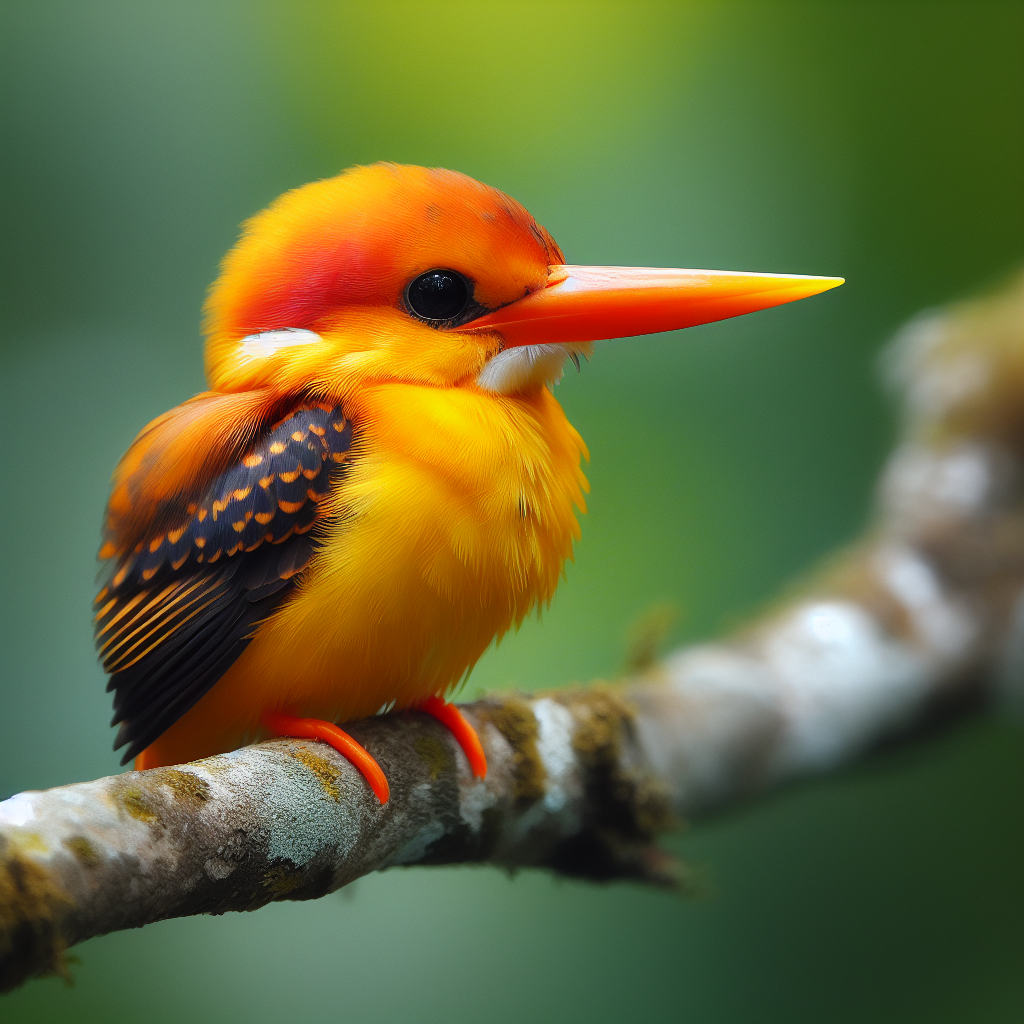Most beautiful small birds - Sykalo Eugen 2024
Rufous-backed Kingfisher (Ceyx rufidorsa)
Identification:
- Species name: Rufous-backed Kingfisher
- Scientific name: Ceyx rufidorsa
- Family: Alcedinidae (Kingfishers)
- Order: Coraciiformes (Rollers and Kingfishers)
- Subclass: Neornithes (Modern birds)
- Class: Aves (Birds)
Description:
- Size: Tiny but vibrant, about 12-14 cm (4.7-5.5 in) long with a wingspan of 22-25 cm (8.7-9.8 in).
- Body shape: Compact and stocky, with a short neck, a long, slightly downcurved beak, and a stubby tail.
- Plumage color:
Males: Dazzling rufous upperparts, contrasting with their bright chrome yellow underparts and electric purple crown and rump. White patch adorns the side of the neck.
Females: Similar to males but duller overall, with less extensive rufous and purple and more streaking on the underparts.
Long, slightly downcurved beak, black.
Short, orange-red legs.
Dark brown eyes.
Behavior:
- Method of feeding: Primarily hunts insects and other small invertebrates, perching on low branches and sallying out to catch prey mid-air. May also glean insects from leaves and branches.
- Reproduction: Builds cup-shaped nests in tree cavities or banks near water. Lays 3-5 glossy white eggs. Both parents care for the young.
- Movement: Resident in most of its range, with some local movements in response to food availability.
- Communication: High-pitched calls and a simple, twittering song, sung by both sexes.
Ecology:
- Habitat: Dense undergrowth in tropical rainforests, often near streams and other water sources. Prefers shady habitats with plenty of vegetation.
- Diet: Insects, spiders, worms, snails, small frogs, and lizards.
- Hunting methods: Perches and scans for prey, then darts out with lightning speed to catch them in its long, dagger-like beak. May also hover near water to snatch aquatic insects.
Distribution: Found in Southeast Asia, from Thailand and the Malay Peninsula to the Greater and Lesser Sundas and western Philippines.

The Rufous-backed Kingfisher, a feathered flash painting the tropical forests with streaks of emerald and rust! This resident of sun-dappled streams might seem like a simple resident of riverbanks at first glance. But beneath its dazzling plumage and piercing calls lies a treasure trove of surprising facts and adaptations that will transform this riverine acrobat into a captivating underwater hunter, hidden feast master, and unexpected social swinger in your eyes.
Masters of the River Ballet: Forget clunky landings; Rufous-backed Kingfishers reign supreme in the domain of cascading waterfalls and sun-dappled currents. Their powerful wings and surprisingly acrobatic skills propel them through the air with breathtaking agility, hovering and diving like feathered torpedoes with built-in miniature jetpacks. Imagine them as river ballet dancers performing synchronized water entries, painting fleeting emerald ripples across the sunlit canvas.
Hidden Underwater Hunter: Don't underestimate their aquatic prowess! Rufous-backed Kingfishers are expert divers, plunging effortlessly into crystal-clear streams with pinpoint accuracy. Their long bills act like feathered spears, impaling small fish and aquatic insects with lightning speed. Think of them as riverine snipers with built-in miniature harpoons and an innate underwater radar.
Feasters Beyond the Fish: While fish are their usual fare, Rufous-backed Kingfishers are opportunistic omnivores, readily adapting their menu to seasonal bounty. From juicy fruits and tender larvae to small reptiles and even the occasional amphibian, their varied appetite keeps them fueled for energetic foraging sessions. Think of them as feathered riverbank gourmands with built-in miniature buffets hidden within the riparian labyrinth.
Singing with Riverine Spirit: Their calls aren't just loud shrieks. Rufous-backed Kingfishers possess a distinctive repertoire of whistles and trills, often echoing melodically through the forest canopy. Their voices rise above the rushing water like feathered oboe players, serenading the sun-dappled streams with their vibrant spirit and playful partnership.
Unexpected Social Swingers: They're not always solitary hunters. During breeding seasons, Rufous-backed Kingfishers form loose and playful flocks, flitting through the foliage in flashes of emerald and rust. These feathered skydivers, in playful mid-air chases and synchronized dives, paint fleeting patterns of turquoise and green across the forest canopy.
Champions of Ecosystem Health: They're not just colorful residents. Rufous-backed Kingfishers play a vital role in the health of tropical ecosystems. Their insect feasting controls pest populations, while their droppings fertilize the soil, making them feathered riverbank doctors with built-in miniature pest-control systems and environmental beautification kits.
Cultural Charmers: Across Southeast Asia and the Indian subcontinent, the Rufous-backed Kingfisher has held diverse cultural significance. In some regions, it's seen as a symbol of good luck and prosperity, its vibrant plumage inspiring hope and joy. In others, its agility and skill as a hunter have led to associations with resourcefulness and determination.
Unexpected Regional Variations: Did you know? Not all Rufous-backed Kingfishers are the same! Different populations across their vast range show subtle variations in plumage color and call patterns, adding a touch of feathered diversity to this adaptable species.